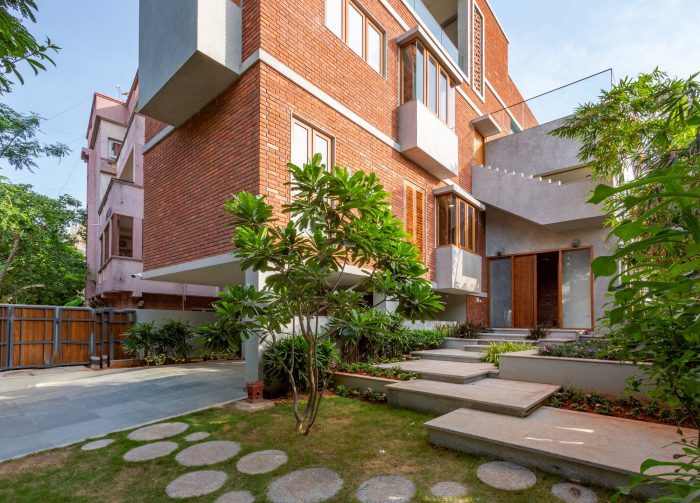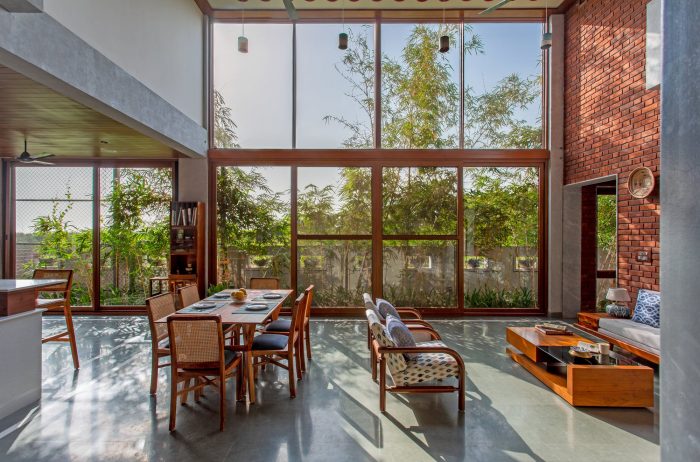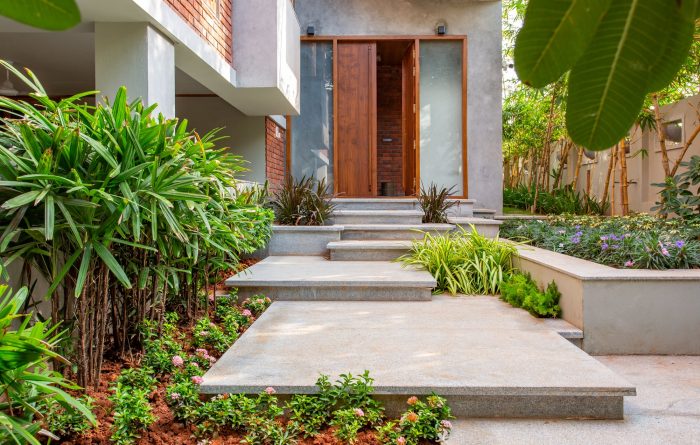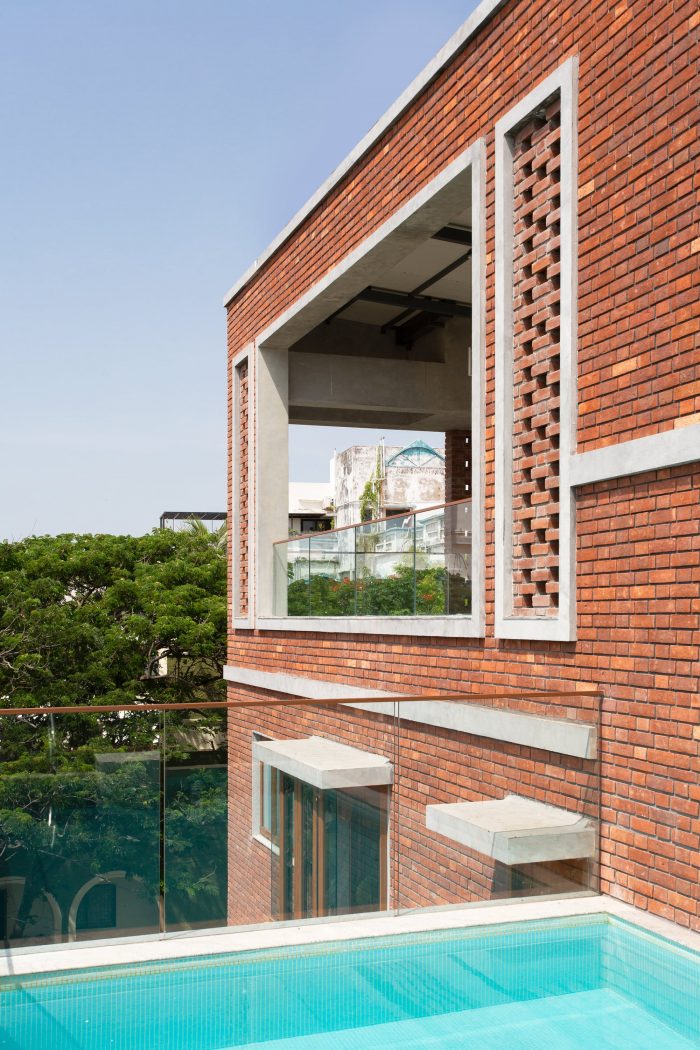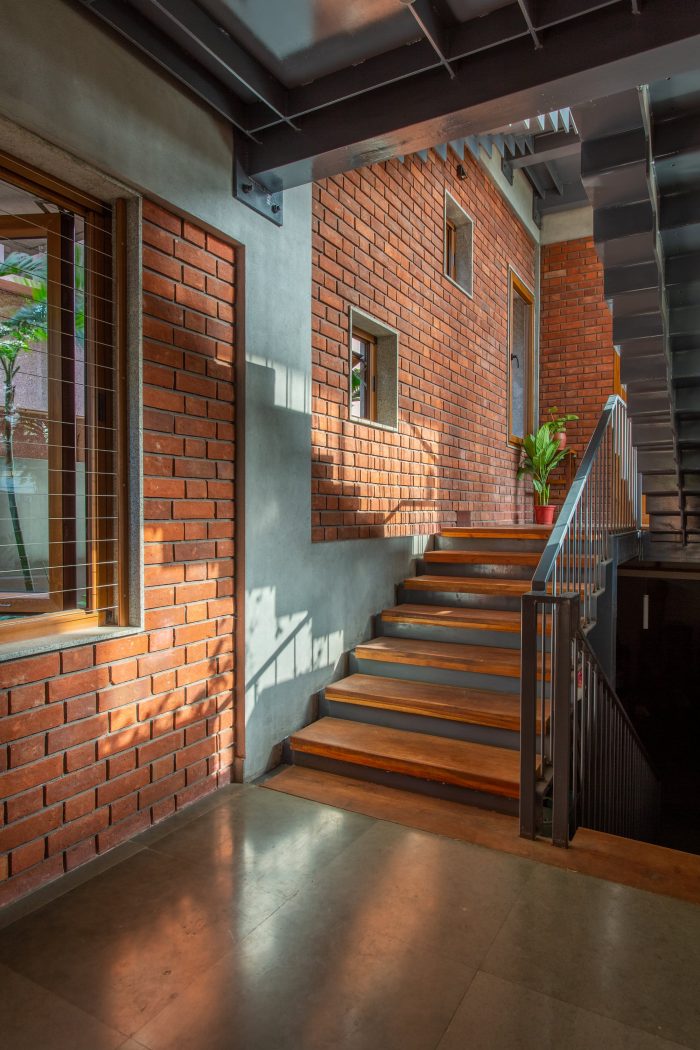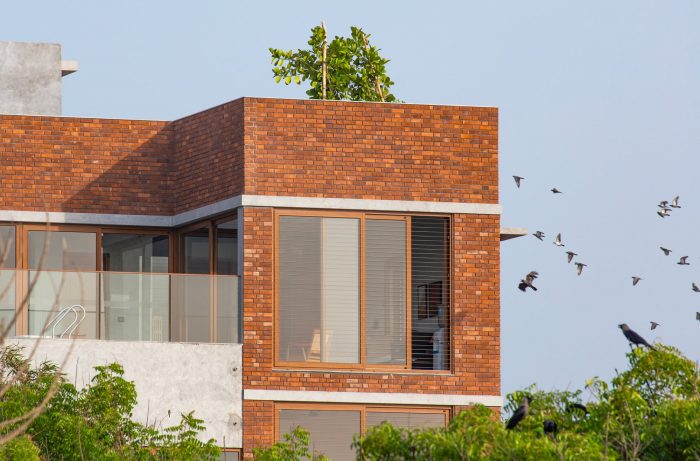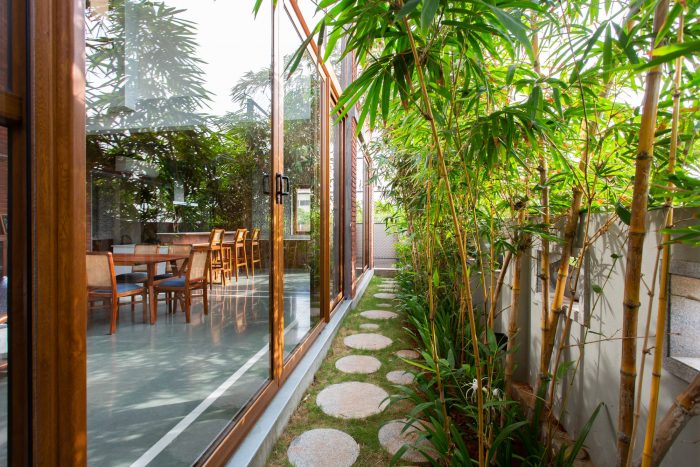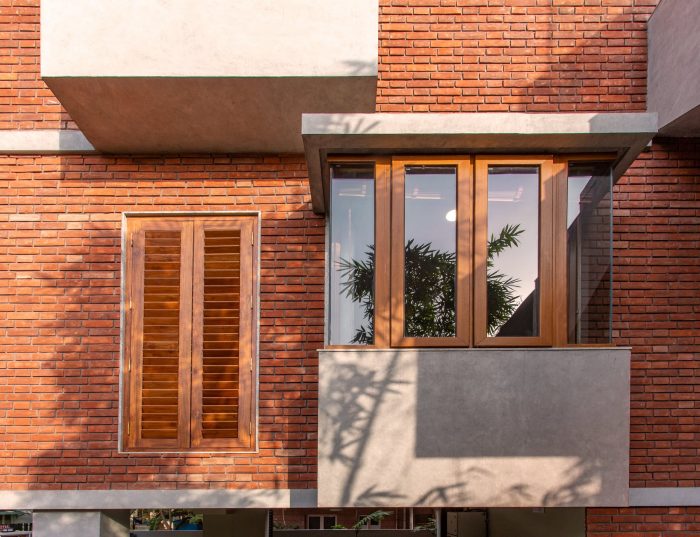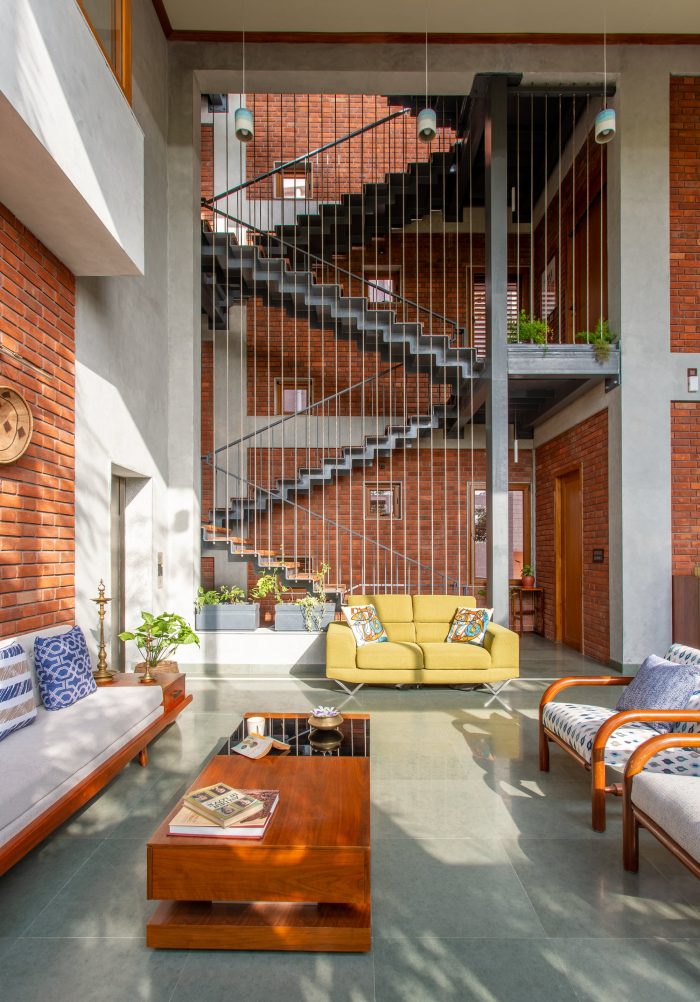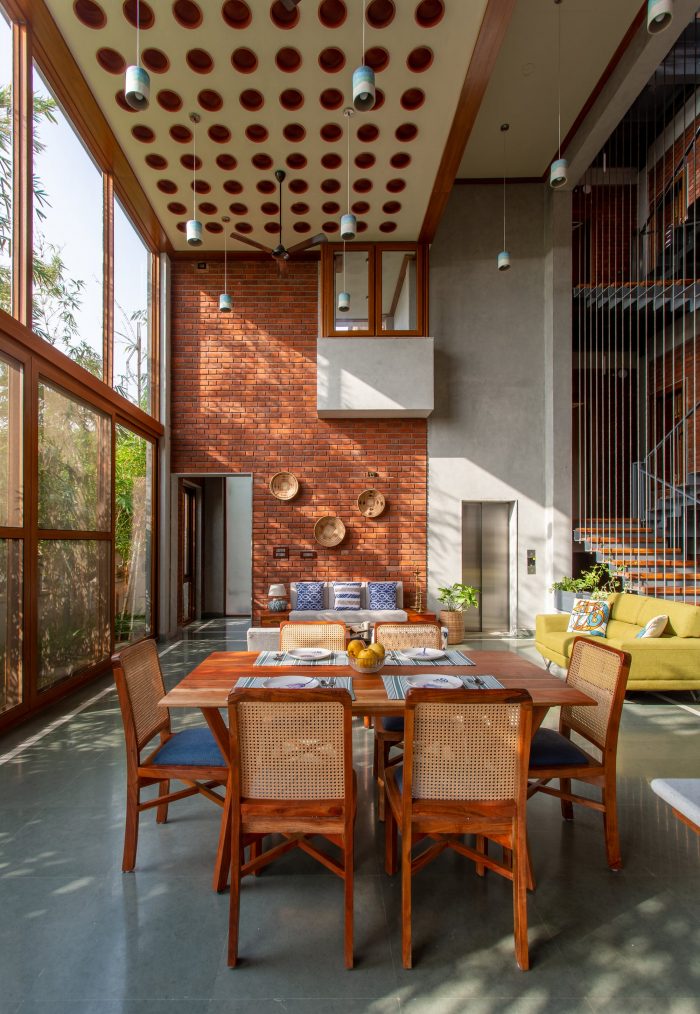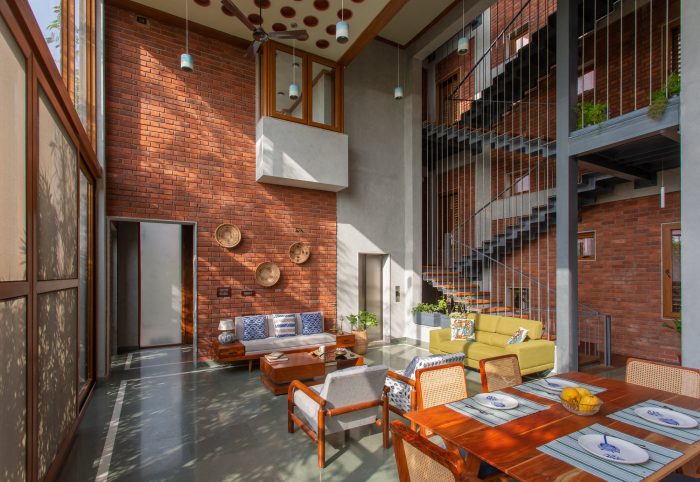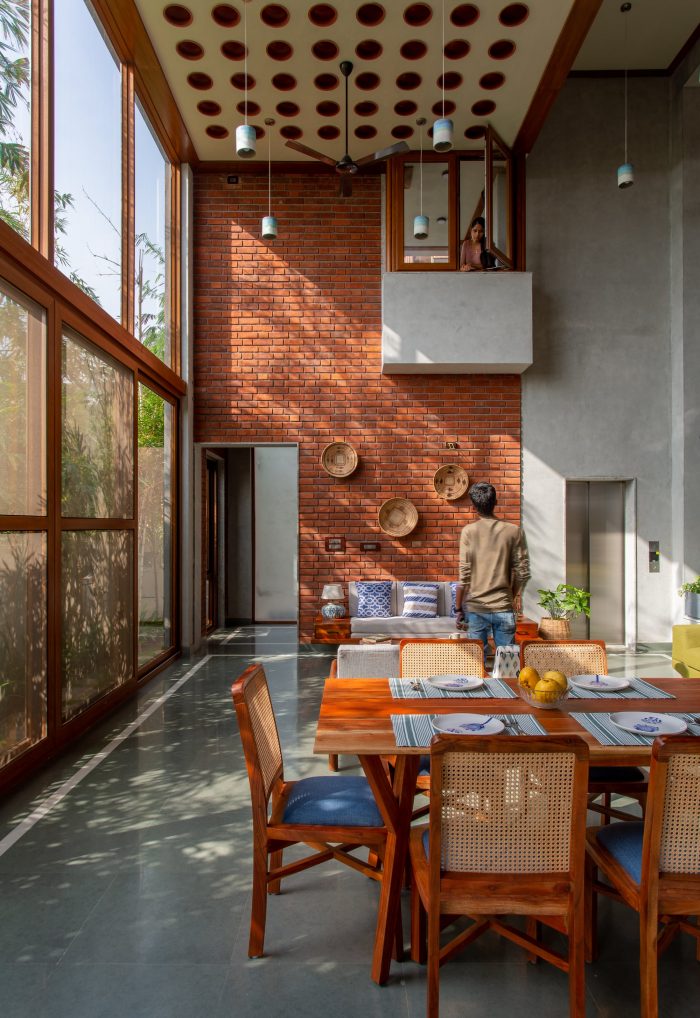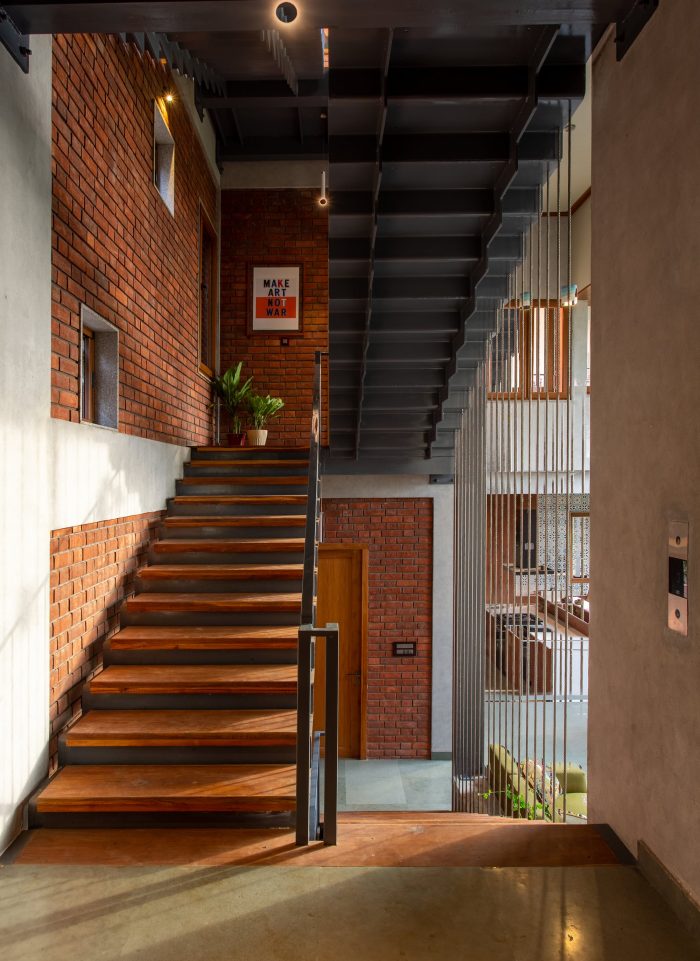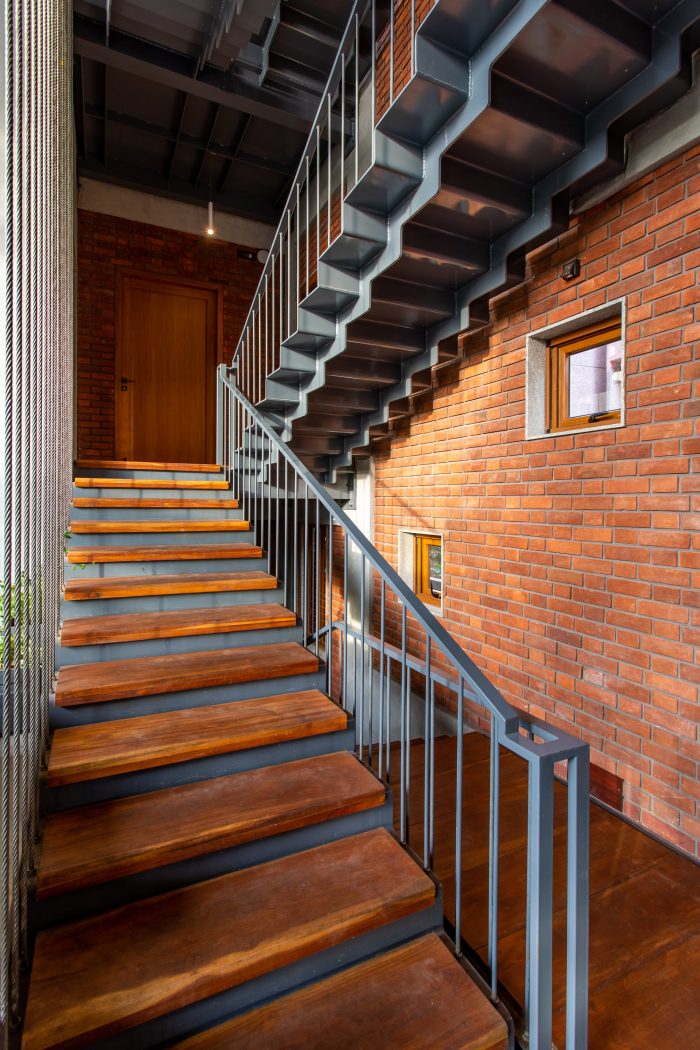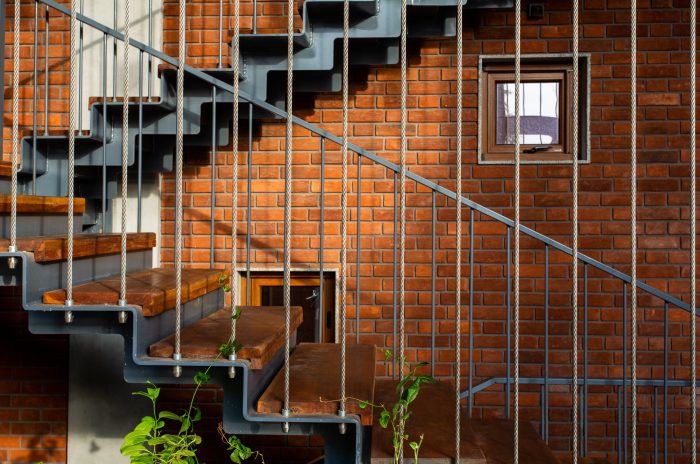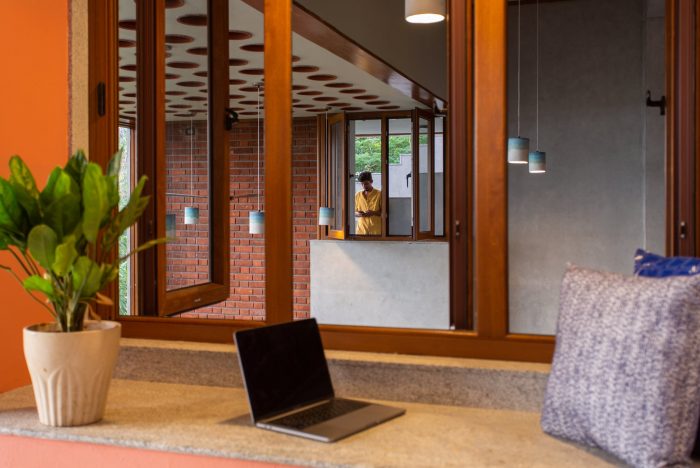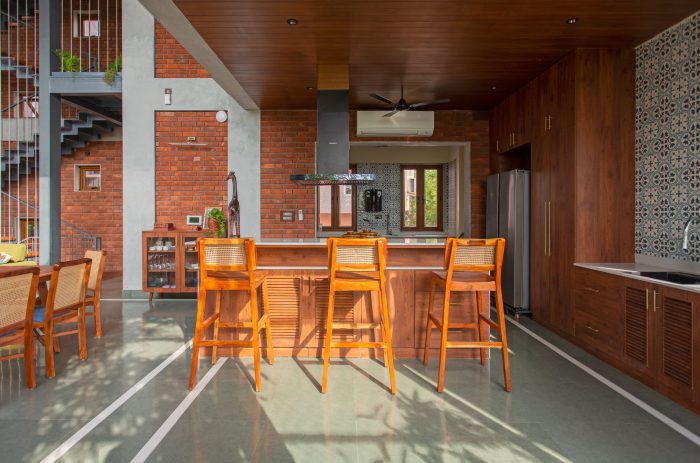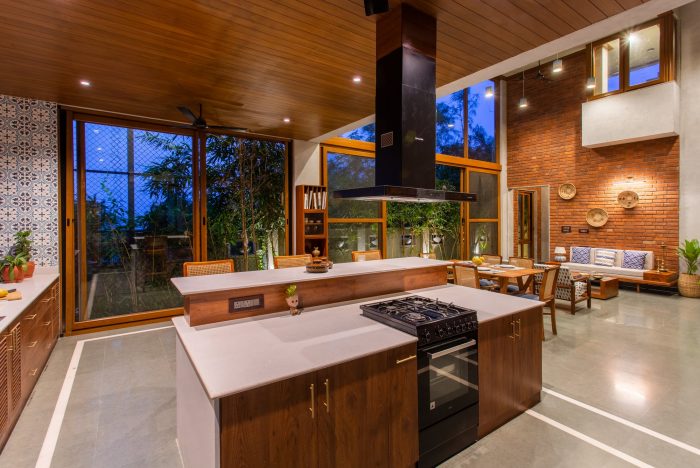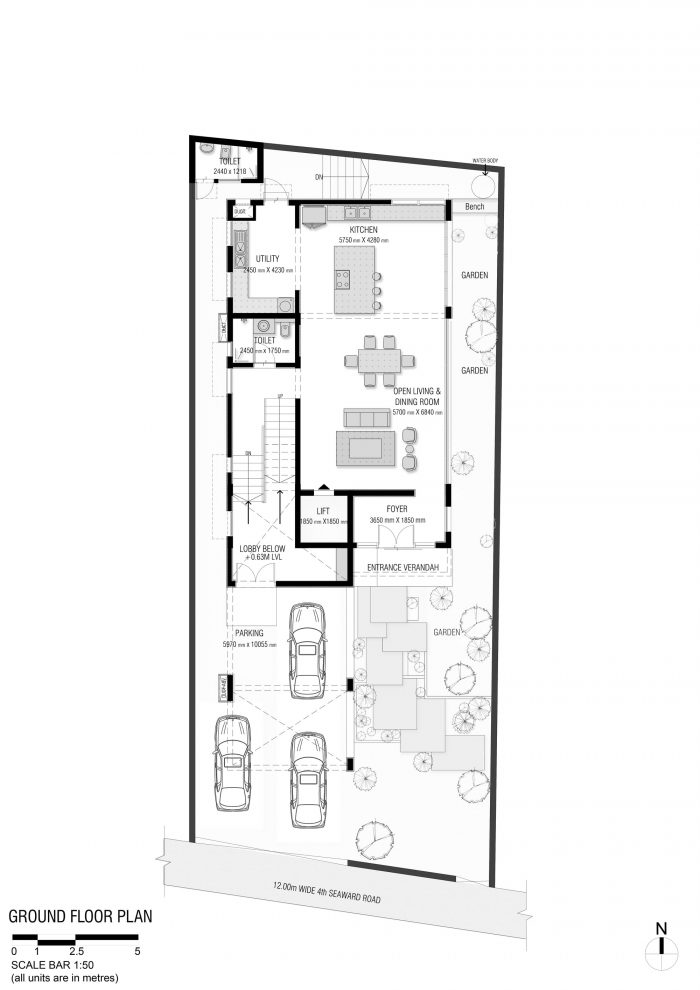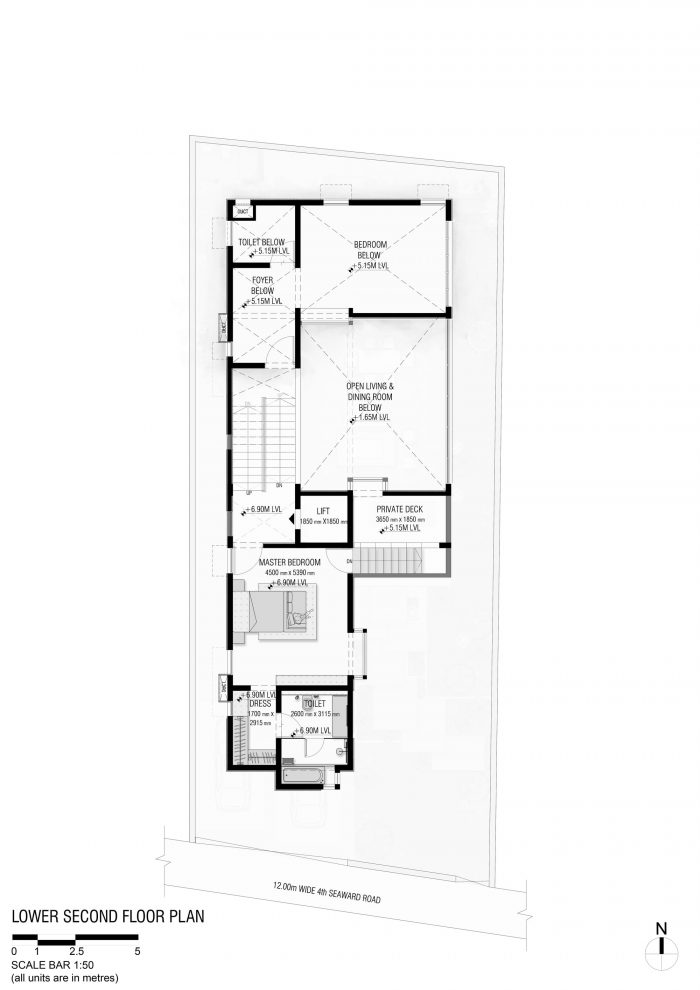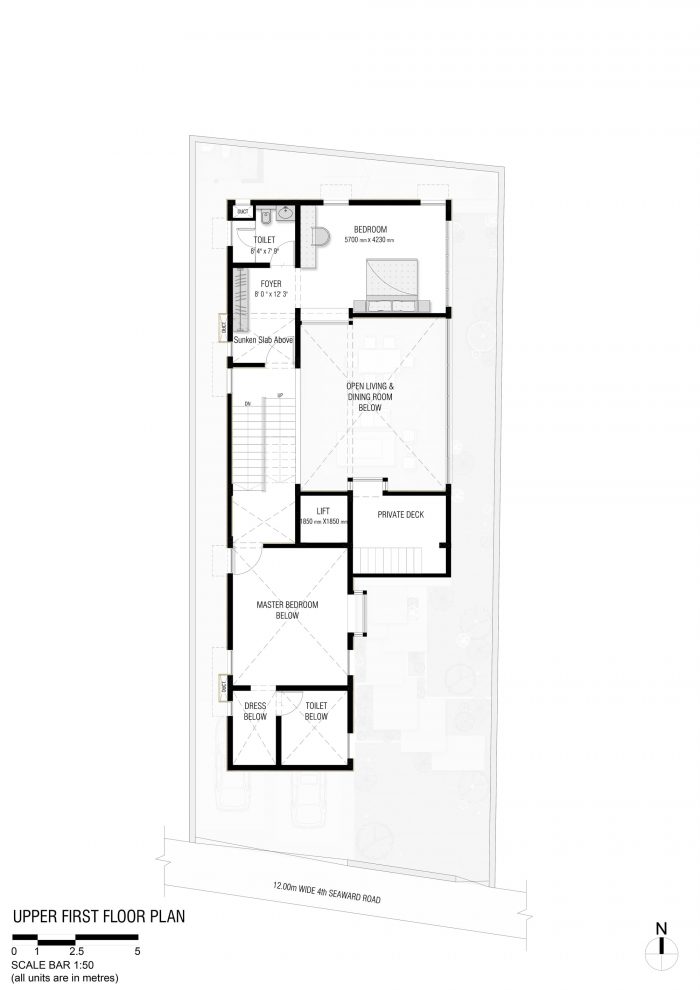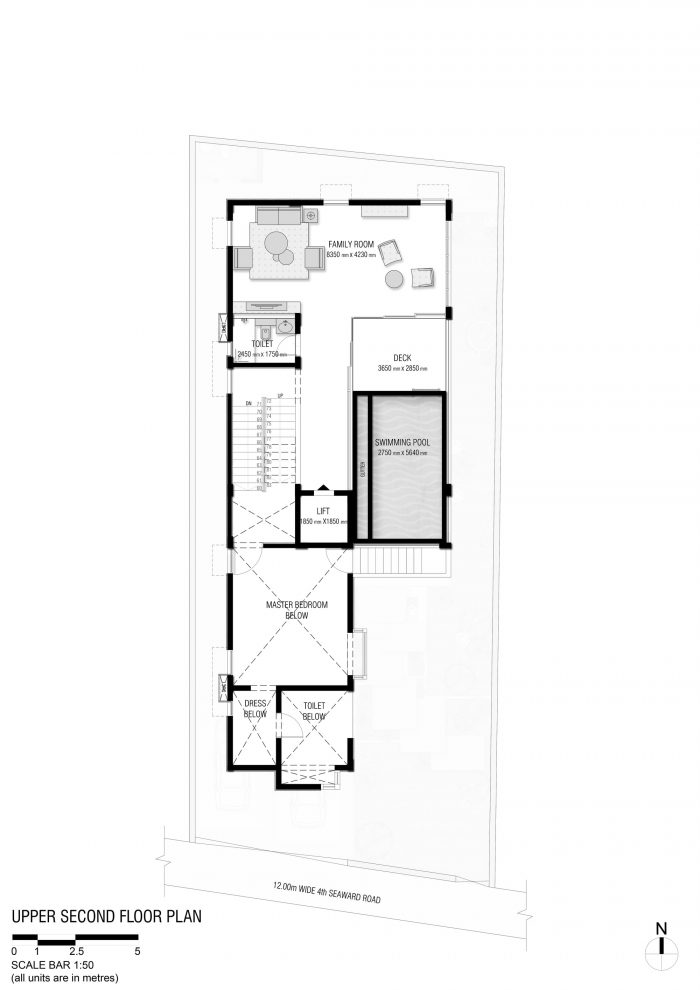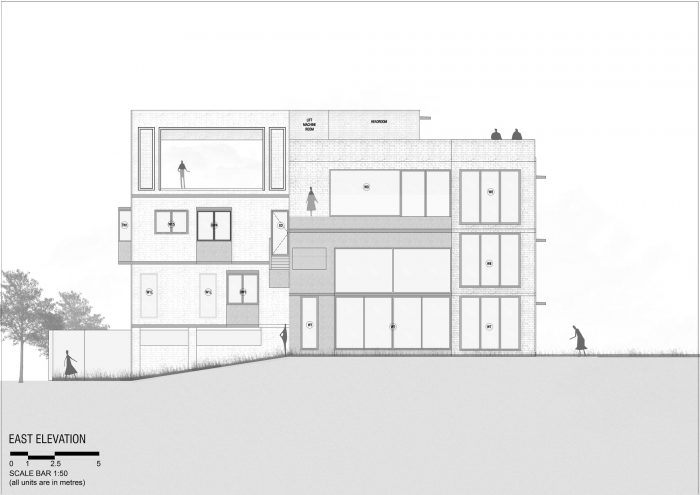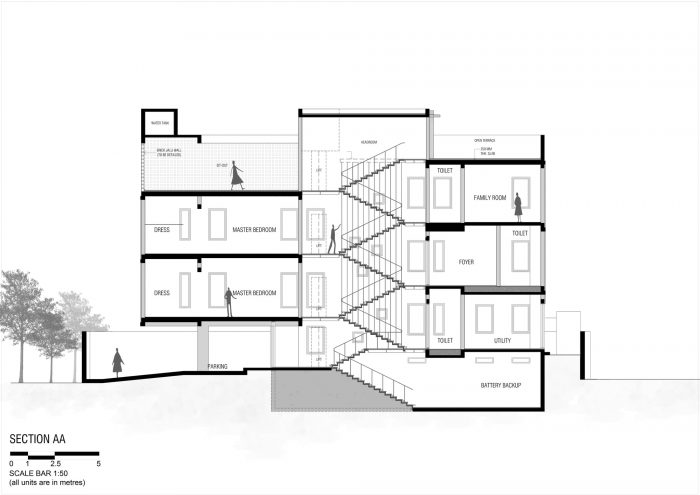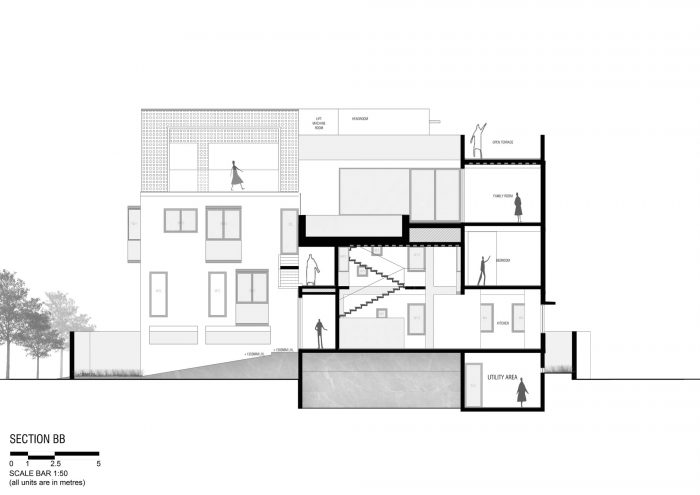该项目位于钦奈一条安静的住宅街的尽头,可以俯瞰大海–项目现场需要一栋向周围开放并提供自身的房子,但同时也被一层层的隐私和屏障所包裹,使其免受开放环境的影响。设计简介非常简单,因此更具挑战性–这是一位父亲送给他即将结婚的女儿的礼物,而这所房子将是她新旅程的起点。39’x93’的直线型地块,其较大的一面面向大海,可以看到孟加拉湾的美丽景色。像每个海滨房产一样,一个默认的要求是确保房子的每个部分都能看到大海。
Located on the end of a quiet, residential street in Chennai, overlooking the ocean – the project site called out for a house that opened and offered itself to the surroundings but also swaddled in its layers of privacy and barriers shielding itself from the open environment it is placed in. The design brief was very simple hence making it much more challenging – a gift from a father for his daughter who was getting married, and the house would be the starting point of her new journey. The 39’x93’ linear plot had its larger side facing the ocean front with a beautiful view of the Bay of Bengal. Like every beachfront property, a default requirement was to ensure that every part of the house had a view of the ocean.
设计规划。整个房子被抬高了1.5米,有一个蜿蜒的人行通道,通过一个入口花园,引导用户进入房子。服务和公用设施,如停车场、帮手的住处和备用电池室被放置在一个部分地下室。入口花园将用户带入一个小门厅,将人们带入一个大房间。正是通过这个大房间,该项目获得了它的名字–“山沟住宅”。这个大房间的灵感来自于城市老区的一条简单的充满活力的街道(沟渠)。这条街是所有居民聚集的地方–对话发生,纽带形成,人们听到了笑声、孩子们的玩耍声和一大堆的欢乐。同样地,大房间被设想为用户的大部分快乐记忆产生的地方,是房子所有活动的核心。这个三层楼高的空间有一个开放的起居室-餐厅-厨房的布局,它向一个线性花园开放,可以看到外面的大海。一旦进入这个空间,用户就远离了城市的喧嚣,进入了一个属于自己的世界。
Design Planning. The entire house was elevated by 1.5meters with a meandering pedestrian approach through an entry garden that led the user into the house. The services and utilities like the car parking, helper’s accommodation, and battery backup room were placed in a partial basement. The entry garden takes the user into a small foyer that leads one into a large great room. It is through this great room that the project derives its name – “The Gully Home”. The great room takes its inspiration from a simple vibrant street (gully) in the older parts of the city. The street is where all the residents assemble – conversations take place, bonds are formed, and one hears the sound of laughter, children playing, and a whole lot of joy. Similarly, the great room is envisaged as where most of the happy memories of the users are made and is the core of all activities of the house. The triple-height space has an open living-dining-kitchen layout, that opens itself into a linear garden with a view of the sea beyond. Once within the space, the users are cut away from the hustle and bustle of the city and enter a world of their own.
传统的住宅会涉及到三层楼的平面叠加。但为了进一步加强垂直交叉连接,楼板在三层高度空间的两侧错开了5英尺,创造了从其他空间进入大房间的视野。这些楼板由一个开放的金属狗腿楼梯连接,每一层都将用户带入一个卧室。每间卧室都有一组内部凸窗,向下看向大房间,从而使整个空间在视觉上和物理上相互连接。除了内部的窗台,还有一组外部的窗台,可以看到180度的海景,还有一个小座位,使之成为一个舒适的阅读/咖啡角落。
A conventional residence would involve floor planes stacked across three levels. But to further enhance vertical cross connectivity, the floor plates are staggered by 5 feet on either side of the triple height space, creating views into the great room from the other spaces. The floor plates are connected by an open metal dog-legged staircase with each flight leading the user into a bedroom. A set of internal bay windows from every bedroom look down into the great room thus making the entire space, visually and physically interconnected. In addition to the internal bay windows, a set of exterior ones project themselves out to get a 180 view of the ocean with a small seat making it a cozy reading/coffee nook.
主卧室有一组私人楼梯,通向夹在门厅和游泳池之间的私人露台。露台的正面可以直接看到大海,右侧是入口处的花园,左侧的凸窗可以看到大房间,从而真正成为夫妻二人的主空间。最上面一层是休息室,可以俯瞰游泳池。玻璃窗的设计方式是,一旦打开,甲板就成为休息室的一部分,直接与游泳池相连。最后,房子的最顶层是一个露台,由砖砌的jaalis围成,创造了面向海洋的框架式开口。
The master bedroom has a set of private stairs that lead to a private terrace sandwiched between the foyer and the swimming pool. The terrace gets a direct view of the ocean on the front, the entry garden on the right, and a bay window looking down into the great room on the left, thus truly making it a master space for the couple. The uppermost level hosts the lounge room overlooking a swimming pool. The glazing is done in a manner that once opened; the deck becomes a part of the lounge connecting it directly with the pool. Finally, the topmost level of the house is a terrace sit-out enclosed by brick jaalis creating framed openings towards the ocean.
生物气候的设计方法和材料。虽然朝东的建筑在创造直接的海洋景观方面效果很好,但它也面临着炎热的早晨太阳的愤怒,导致巨大的热量增加。整个外墙是双层的,内芯是一层多孔砖,两边是半截砖。建筑外皮使用天然粘土材料,使内部空间得到冷却,同时也将热量保留在墙内,而不是传递出去。虽然这解决了实心墙内的热增益问题,但为了获得广阔的海洋景观,必须给予大面积的玻璃,这将导致空间内的热增益。我们设计了一个窗户系统,每个窗户都由一个向内打开的玻璃百叶窗和一个带有可操作百叶的外铝百叶窗组成。因此,以下6种情况是可能的 – 1. 1.完全关闭,没有能见度和通风。2. 完全打开,有能见度和气流 3. 视觉上开放但没有气流 4. 部分能见度,有50%的气流 5. 5.无能见度,25%的气流 6.50%的能见度,无气流。这个系统让用户根据需求和可用性改变房间内的体验。
Bio Climatic Design Approach and Materials. While the east-facing building works well in creating direct views toward the ocean, it also faces the wrath of the hot morning sun causing immense heat gain. The entire façade is double-skinned with a layer of porotherm blocks forming the inner core and half-cut bricks on either side. The use of natural clay materials for the exterior skin of the building results in cooling the interior spaces and also retains the heat within the walls instead of transmitting it. While this solves the heat gain within the area of solid walls, for expansive views of the ocean it is essential to give large glazing which would lead to heat gain within the spaces. A window system was designed where each window consisted of an inward opening glass shutter and an outer aluminum shutter with operable louvers. Due to this, the following 6 permutations were possible – 1. Completely shut with zero visibility and ventilation 2. Complete open with visibility and airflow 3. Visually open but no airflow 4. Partial Visibility with 50% airflow 5. No Visibility with 25% airflow 6. 50% Visibility with no airflow. This system lets the user alter the experience within the room based on the requirement and usability.
内墙也是由切片砖和石灰石膏墙组合而成,从外面到里面都延续了这种材料特性。地板是天然抛光的Kota,可以反射热量并在整个过程中保持凉爽。卧室用不同图案的水磨石地板装饰。建筑物的屋顶通常会造成大部分的热量摄入。因此,为了最大限度地减少这种情况,楼板通过插入陶罐作为填充物进行双重绝缘,从而最大限度地减少了楼板中的混凝土用量。阳台的屋顶由太阳能电池板覆盖,因此整个房子可以只使用太阳能来运作。
The internal walls too are a combination of sliced bricks and lime plaster walls continuing the materiality from outside to inside. The flooring is a natural polished kota, that reflects heat and remains cool throughout. The bedrooms are finished with terrazzo flooring of different patterns. The roof of a building usually contributes to the majority of the heat gain. Hence, to minimize this, the slabs are doubly insulated by inserting terracotta pots as fillers that minimize the volume of concrete used in the slabs as well. The roof of the terrace is covered by solar panels hence the entire house can be operated using only solar energy.
室内设计。Gully Home是一个一次性的项目,建筑完全决定了它的内部空间。由于内部与外部的联系,外部和内部材料之间没有区别。切片砖包层和石灰抹灰墙以及暴露的混凝土结构元素构成了主要的室内材料。天花板上的陶罐突出了这些材料,为空间增添了有趣的色彩。房屋内没有使用假天花板,所有的板块都是裸露的混凝土。家具是木材与织物和藤条的组合,以延续房屋内的乡村主题。大多数家具都是使用工匠木匠定制的,并根据用户的具体要求进行设计。Gully Home是一种尝试,重新想象现代家庭生活如何以可持续的方式存在。它是一个植根于环境的房子,对周围所有的建筑和气候要求做出反应,从而使它成为气候响应和功能设计原则的体现。
Interior Design. The Gully Home is a one-off project where the architecture completely defines its interiors. With a connection of the inside to the outside, there is no difference between the exterior and interior materials. Sliced brick cladding and lime plastered walls along with exposed concrete structural elements form the major interior materials. The terracotta pots on the ceiling accentuate these materials and add an interesting touch to the space. No false ceiling is used within the house and all the slabs are exposed concrete. The furniture is a combination of wood with fabric and cane to continue the rustic theme within the house. Most of the furniture is custom-made using artisan carpenters and is designed as per the specific requirements of the users. The Gully Home is an attempt at reimagining how modern-day family living can exist in a sustainable manner. It is a house that is contextually rooted and responds to all surrounding architectural and climatic requirements thus making it an embodiment of climatic responsive and functional design principles.
Architects: ED+ Architecture
Area : 6275 ft²
Year : 2022
Photographs :Sreenag BRS
Manufacturers : Toto, Fab India, Freedom Tree, Home Centre, Kalinga Stones, Lightscape, Nexion
Lead Architects : Ammaar Chowdry, Mridula S Chowdry
Architecture & Interior Design : Mano Bharathi, Sai Maalavika, Purva Bhende
Elevator Consultancy : Kone Elevators
Civil Coordinator : Mr. Govindraj
Structural, Mep, Civil Execution & Design : Ramaniyam Real Estate
City : Chennai
Country : India


